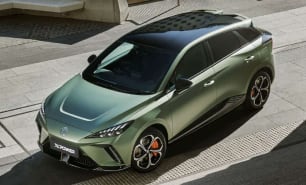The DBX is a circa 550 horsepower giant that can reach out and almost touch 300km/h. But testing it on Sydney's roads is like having a champion racehorse in your backyard and your neighbour asking you what it's like to ride.
A racetrack wasn't handy at the time and I'd signed a form saying I'd not put any more than 400km on the clock during its stay with me, which meant having to choose my test loop carefully.
Fortunately, this was before Sydney was plunged into the current COVID lockdown, which makes that 400km now seem vast.
First, the DBX is an SUV anybody could drive, every day. Visibility is great and the ride is fine considering it rolls on 22-inch wheels and wears rubber as wide as some doorways and as thin as my socks (285/40 front and 325/35 rear Pirelli Scorpion Zero). Power delivery is smooth and predictable.
I did drive it every day, doing the shopping, school pick ups, a trip to the garden centre to fill it with plants and (ahem) compost, and it performed exactly as a large SUV should.
A source of frustration was the location of the shifting buttons high on the dashboard. Have a look at the images. Even with my chimpanzee-like long arms I had to stretch to change from Drive to Reverse. And with a not so small turning circle of 12.4m, three-point turns were a bit of an arm workout.
But the bigger frustration was the driver-car connection which didn't feel quite right. A good car-driver connection is essential for any great performance car.
Yes, there wasn't a race circuit where I could get to know the DBX quickly. But a good road, driven often with test cars, reveals a lot, too.
And the DBX didn't feel as good as the Lamborghini Urus, which is not only more comfortable but feels more dynamic and offers a superb connection between the driver and the machine.
The DBX is fast, it's powerful, the huge brakes pull it up quickly (almost violently so, if required) and handling is incredibly good.
It's just that I didn't really feel a part of it much at all. You know, the whole driver and car becoming one, thing. I felt like the third wheel on a date.
That connected feeling has been mastered by Porsche with its SUVs, but I feel the DBX needs more work. It felt unfinished.
I was told at the start that the DBX I was testing was a pre-production vehicle, but I'm sure that doesn't cover the shortcomings in the way it drove.
It's disappointing. I was hoping for better, but I think further development will see that come later.

